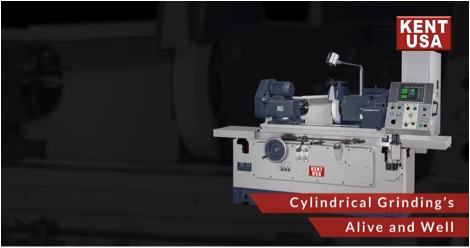Cylindrical grinding is one of the oldest of all machining technologies. Though credit for its invention remains a bit fuzzy, most attribute development of the first production grinding machine to Charles Norton (ironically, not the same Norton of grinding wheel fame), who worked at Brown and Sharpe and was charged by company founder Joseph Brown with working the kinks out of the “universal grinding machine” he’d been struggling with for some time.
Since that time, cylindrical grinding has evolved into the go-to method for producing extremely precise round components such as shafts, mandrels, bearing journals, and core pins, as well as creating formed shapes and contours on a wide variety of turned parts.
With all the talk these days of hard turning, however, never mind the availability of ever more complex, capable, and above all highly accurate CNC lathes, it’s easy to wonder if cylindrical grinding is going the way of cam-actuated screw machines and high-speed steel tool bits.
 Some might welcome that day. After all, grinding has always been a bit of a black art. There’s the wheel selection with all its various grits and grains and bonds to contend with. There are the extreme tolerances to be held, workpieces hardened to the very edge of machinability, and feeds and speeds often determined more by gut feel than they are scientific method.
Some might welcome that day. After all, grinding has always been a bit of a black art. There’s the wheel selection with all its various grits and grains and bonds to contend with. There are the extreme tolerances to be held, workpieces hardened to the very edge of machinability, and feeds and speeds often determined more by gut feel than they are scientific method.
Despite these challenges, grinding isn’t going away anytime soon, no matter how advanced lathe technology becomes. That’s because some parts are simply too difficult or too accurate to machine anywhere else.
Grinding doesn’t have to be difficult, though, nor a matter of tribal knowledge and best guesses. Recent developments in machine tool and control technology have brought grinding success within the reach of virtually any job shop or manufacturing company, regardless of their experience level.
One excellent example of this is Kent USA’s JHU-2706H NC Cylindrical Grinder. With a load capacity of 154 lbs. between centers, maximum grinding diameter and length of 10.6 and 23.6 inches respectively, and a variety of easy-to-use plunge and feed cycles, there’s little this machine can’t handle.
So maybe you’ve been sending parts out to a specialty shop and have grown tired of the long lead-times and high prices. Maybe you’ve tried hard turning and met with limited success. Either way, there’s no reason not to bring your grinding work in-house. It’s not as difficult or mysterious as you might be thinking, and chances are excellent it will lead to additional work. Whatever else happens, cylindrical grinding is alive and well, thank you.
Kent Industrial USA, Inc.
1231 Edinger Avenue
Tustin, CA 92780 USA
www.kentusa.com
